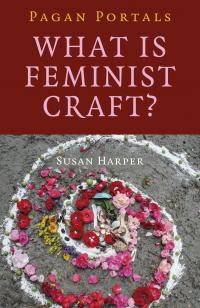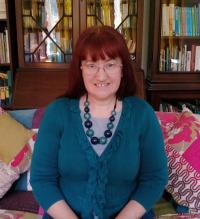

Maud Gonne and Occult Experiences
By Connie Pina Rounds
Edith Maud Gonne
December 21, 1866 - April 27,1953
History recognizes Maud Gonne most notably as an Irish revolutionary. She was a voice for the people and the prisoners living in poor conditions. She fed hungry children. And she was a voice for the women's movement.
Maud's reputation for being the muse of W.B. Yeats may equally match, if not outshine her own personal achievements. But beyond both these most notable attributes, she was so many other things including a mother, a wife, an actress, a journalist, an artist, a free spirit, and most interestingly an occultist.
Maud's life choices and beliefs are shaped by these adventures. She even names a chapter of her autobiography "Occult Experiences." Maud was fascinated her entire life with the ideas of reincarnation, life after death, astral projection, lucid dreaming, and using magic for power. Her ability to travel in the astral vision, while in a trance or in dream state and gather information is remarkable. She is a natural at piercing the veil and getting a glimpse beyond. She even hears voices from the other side when she meditates with burning incense (Gonne-Yeats, 33).
How does one become defined as an occultist? Is it by picking up a book that reveals hidden knowledge? Is it by joining a secret society that teaches such things? Is it by conversation with the dead, or higher beings such as your Holy Guardian Angel? Or are you just born that way? It was most likely all of the above in Maud's case.
It was in 1889 when Maud met the now infamous Irish poet William Butler Yeats, who was a member of the Hermetic Order of the Golden Dawn. In 1891 she joined the HOGD and was given the magical motto Per Ignem ad Lucem , which is Latin for "Through fire to the light." Over the next few years Maud passes through four initiations. She even writes Yeats that she has conversation with him while traveling in the astral vision in Prithivi and Akasha (Yeats-Gonne, 53).
As a child and through her adult life, Maud remembers being watched over by an apparition she refers to as "The Grey Lady." She gave her this nickname because she often showed up dressed in grey veils and Maud describes her as "a beautiful dark woman with sorrowful eyes." And she also says, "She was rather like me, but smaller and darker." The Grey lady's visit occurred mostly at night and never seemed to be related to anything in particular.
Maud shares her story about the Grey Lady with Yeats. He decides to share this story with his friend McGregor Mathers who happens to be a fellow magician and the head of the Golden Dawn Society. Yeats and Mathers come up with a theory from their knowledge on Egyptian magic that the Grey lady is Maud's Ka, meaning a part of her personality that survived death in a former incarnation. Mathers explains to Maud that Egyptian Priests use to preserve mummies to keep the Kas of the dead people. Then they could use them to perform magic.
Based on this theory, Maud decides if this is a part of herself, then she could call on her "dark beautiful friend" to become an expression of her will. Maud sends her to influence and persuade other people to make decisions in her favor. She notes the woman happily does them and looks less sad. The more she invoked the Grey Lady, the stronger her energy came in.
Soon, she begin to develop her own personality. Maud says, "She liked some people, disliked others. I loved children; she disliked them." A few of the Golden Dawn Members decided to throw a séance to find out more about the Grey Lady. During the Séance, Mather's wife Moina, says that the Grey Lady is sorrowful and remorseful because she killed a child. Maud is upset by this statement and decides to stop working with and acknowledging the Grey Lady's presence ( Gonne, 207-208).
Before Maud became Catholic, she practiced Buddhism. So, it is no surprise that Maud contemplated reincarnation. Around three weeks prior to her first meeting with Yeats, Maud had given birth out of wedlock to a baby boy named Georges. Yeats did not learn the truth of her child and love affair with Lucien Millevoye until a much later time. Millevoye was a French politician who was 16 years older than Maud.
Georges passed away at 2 years from most likely meningitis. This is a very heartbreaking event for Maud. She and Yeats meet in Ireland shortly after her child's death and she tells him that she had a dream about him. They were brother and sister in a past life and were sold into slavery.
This is also around the time that she is new to the Golden Dawn group. She repeatedly asks about the possibilities of recreating a dead child's soul. One of Yeat's friends, a mystic named George Russell, assures her that if the parents go about it in the right way then it is possible.
So, in 1893, Maud contacts Millevoye and has him meet her where their child was laid to rest at a cemetery in the small riverside town of Samois-sur-Seine, 50km (30 miles) south-east of Paris. They both proceed down a metal ladder in the crypt of where their child's coffin laid and have sex.
The hope was that by having intercourse next to the corpse, the process of metempsychosis - the transmigration of the soul would take place. Whether this occurred successfully is not known, but Maud did have another baby as a result of this meeting. This time it was a girl she named Iseult (Schofield).
Maud exhibits strong abilities with astral projection and lucid dreaming through her life. One night she decides to try haschish before falling asleep. She wakes up to a tall shadow figure at the foot of her bed. It tells her, "You can now go out of your body and go anywhere you like but you must always keep the thought of your body as a thread by which to return. If you lose that you may not be able to return."
She astral projects to visit her sister. She even astral projects to her friend Cipriani who doesn't believe in the supernatural. She takes him by surprise when she tells him not only what she saw him doing, but also what she saw him wearing. He had a red scarf around his shoulders. He admits his Landlady draped a red flannel around him because he was sick (Gonne, 203-205).
Maud's relationship with Yeats is one that is truly fascinating and esoteric. History often creates a lopsided love story of Yeats being some-what obsessive with Maud and constantly rejected. One must read Maud's letters to Yeats to learn the truth. She was just as obsessive with him more so on an astral level. She was constantly astral projecting to him or dreaming about him from the moment they started spending time together.
And there are times you can see him pulling away because maybe he's trying to date someone else or he's brooding because he's lonely and she's not available to be with him because she's married. You can sense her frustration when he shuts down and doesn't write her for lengthy periods of time. She is persistent with him. She never pulls away from him. She places more value in her spiritual relationship with him than she does in own mundane marriage.
In December of 1898, Maud experiences a dream in which she is carried into the spirit realm and married to Yeats. That same evening Yeats had a dream in which she kisses him. And thus, begins their spiritual union and what they considered to be a mystical marriage. A couple years later, the astral marriage is put on hold. Yeats and Maud become estranged for 6 years, after Maud marries Major John MacBride.
In 1908, Maud and Yeats meet in Paris and the Mystical Marriage is back on. Maud gifts Yeats with a notebook bound in white vellum, that he uses to record dreams, visions astrological events pertaining to their relationship. And based on her letters, one can conclude even their mundane relationship has become romantic and finally including sex between the two.
Yeats makes evocations for their spiritual union using Mars and Venus for representing the masculine and feminine forces. On July 25, Yeats is at Coole Park, and makes an evocation. For the first time, he "saw it bright and shinning." The same night, Maud is in Paris and finds herself astral projecting to Yeats. She writes "I was conscious of starlight and of hearing the sea below us. You had taken the form I think of a great serpent, but I am not quite sure. I only saw your face distinctly and as I looked into your eyes your lips touched mine. We melted into one another till we formed only one being, a being greater than ourselves who felt all and knew all with double intensity." She then later that night dreamed that they went to Italy together and were quite happy (Gonne-Yeats, 257).
Although their mundane relationship cools down, Maud remains committed to him in their friendship and to their Mystical Marriage. "I know," she wrote him in 1909, "the spiritual union between us will outlive this life, even if we never see each other in this world again (Gonne-Yeats, 259)." That's a promise I'm certain she intends to keep to her beloved Yeats.
Works Cited
Gonne, Maud. The Autobiography of Maud Gonne: A Servant of the Queen. University of Chicago Press,1995.
Gonne,Maud and Yeats, WB. The Gonne-Yeats Letters. Syracuse University Press, 1893-1938
Gorski,William T. Yeats and Alchemy. SUNY Press, 1996.
Schofield, Hugh. Ireland's heroine who had sex in her baby's tomb. BBC News, Paris, 2015.
Categories:
0 comments on this article






